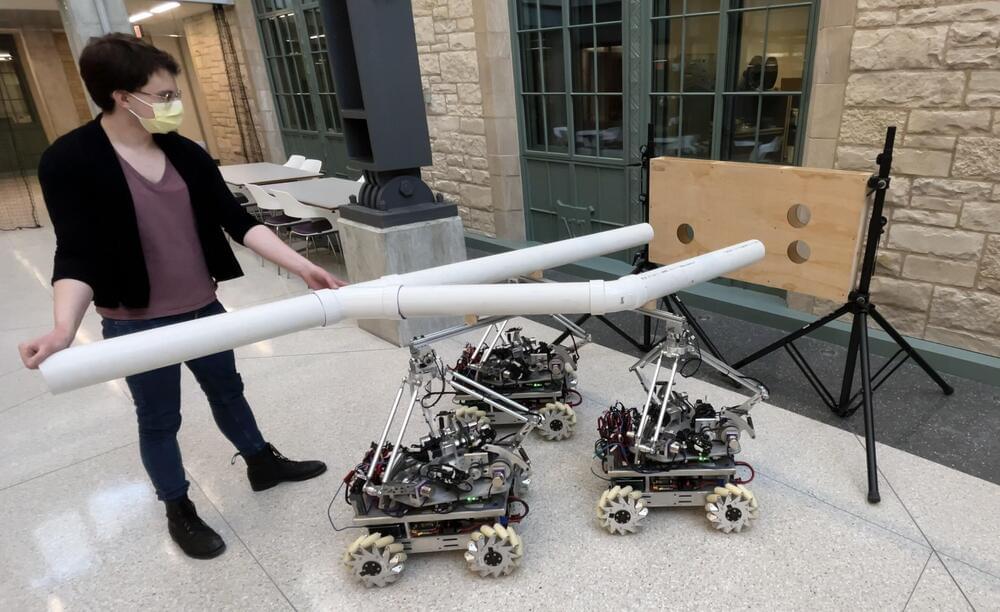Page 4890
Jul 31, 2022
These Affordable Solar Homes in Sweden Produce as Much Energy as They Use
Posted by Shubham Ghosh Roy in categories: solar power, sustainability
The compact row houses feature carefully angled solar panels that harness every moment of the sun.
Jul 31, 2022
The Omnid Mocobots: New mobile robots for safe and effective collaboration
Posted by Shubham Ghosh Roy in categories: robotics/AI, transportation

Teams of mobile robots could be highly effective in helping humans to complete straining manual tasks, such as manufacturing processes or the transportation of heavy objects. In recent years, some of these robots have already been tested and introduced in real-world settings, attaining very promising results.
Researchers at Northwestern University’s Center for Robotics and Biosystems have recently developed new collaborative mobile robots, dubbed Omnid Mocobots. These robots, introduced in a paper pre-published on arXiv, are designed to cooperate with each other and with humans to safely pick up, handle, and transport delicate and flexible payloads.
Continue reading “The Omnid Mocobots: New mobile robots for safe and effective collaboration” »
Jul 31, 2022
Space Command moving to Alabama: 4 steps remain; what’s next?
Posted by Genevieve Klien in categories: military, space
The U.S. Space Command’s proposed move to Huntsville passed a big test July 13 when the Pentagon released a draft environmental assessment finding “no significant impacts on the human or natural environment” if the headquarters is built on the Redstone Arsenal site.
Although there remain four steps ahead of the move, Republican U.S. Sen. Tommy Tuberville of Alabama said the environmental assessment should be the last major hurdle for the plan to move the command from startup headquarters in Colorado to a permanent site. The move would bring 1,800 headquarters staff and their families to north Alabama.
“The Redstone Arsenal site is the (Department of the Air Force’s) Preferred Alternative for implementation of the Proposed Action,” the environmental assessment said. The proposed action is a permanent headquarters.
Jul 31, 2022
Scientists Discover Unique Triple Star System
Posted by Genevieve Klien in category: space
International scientists disocvered a tertiary, or triple, star system with a third star orbiting a binary of two stars. The stars are massive in size.
Jul 31, 2022
Huge network of 11,000 fake investment sites targets Europe
Posted by Genevieve Klien in category: futurism
Researchers have uncovered a gigantic network of more than 11,000 domains used to promote numerous fake investment schemes to users in Europe.
The platforms show fabricated evidence of enrichment and falsified celebrity endorsements to create an image of legitimacy and lure in a larger number of victims.
The goal of the operation is to trick users into an opportunity for high-return investments and convince them to deposit a minimum amount of 250 EUR ($255) to sign up for the fake services.
Jul 31, 2022
How deepfakes could soon change our world
Posted by Genevieve Klien in category: futurism
It may look and sound a little rough around the edges right now, but as the technology improves, the possibilities of spinning words and images out of thin air are endless.
Deepfake Bill Whitaker: I’m Bill Whitaker.
Bill Whitaker: Wow. And the head, the eyebrows, the mouth, the way it moves.
Jul 31, 2022
AI’s prediction of what last selfies on Earth would look like are total nightmare fuel
Posted by Sean Brazell in category: robotics/AI
🤔 I certainly hope not!
An artificial intelligence program asked to predict what “the last selfie ever taken” would look like resulted in several nightmarish images.
TikTok account Robot Overloards, which dedicates its page to providing viewers with “daily disturbing AI generated images,” uploaded a video on Sunday where the AI DALL-E was asked to predict what the last selfies on Earth would look like.
Jul 31, 2022
Sources: Elon Musk to build his own airport outside Austin
Posted by Gemechu Taye in categories: Elon Musk, space travel, sustainability
Jul 31, 2022
A new robotic submersible could unlock the mysteries of Greenland’s underwater glaciers
Posted by Gemechu Taye in categories: chemistry, climatology, robotics/AI, sustainability
You’re in for a surprise.
Picture the ocean, impacted by climate change.
Rising sea levels, ocean acidification, melting of ice sheets, flooded coastlines, and shrinking fish stocks — the image is largely negative. For the longest time, the ocean has been portrayed as a victim of climate change, and rightly so. Ulf Riebesell, Professor of Biological Oceanography at the Geomar Helmholtz Centre for Ocean Research Kiel, has studied the effects of global warming on the ocean for nearly 15 years, warning the scientific community about the impacts of climate change on ocean life and biochemical cycles. countries aiming to achieve a climate-neutral world by mid-century, experts have decided to include the ocean to tackle climate change.
















